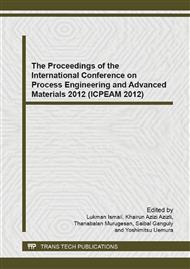[1]
Walas S.M., (1990). Chemical process equipment, selection and design, Butterworth-Heinemann, USA.
Google Scholar
[2]
Richard and Zadri, (1980). Fertilizer manual, development and transfer of technology, United Nations , UNIDO, Series No. 113, New York.
Google Scholar
[3]
Bruynseels J. P., (1981). Granulate in Fluid Bed. Hydrocarbon Processing, Sep. 1981: 203-208.
Google Scholar
[4]
Roberts A.G. and Shah K.D., (1975). The large scale application of prilling. The Chem. Engr., 748-750.
Google Scholar
[5]
Masters, K. (1991). Spray drying handbook (5th ed. ), England; Longman Scientific & Technical, 572.
Google Scholar
[6]
Rahmanian, N. (1997). Modeling of the urea prilling process., MSc thesis, submitted to School of Eng., Shiraz University, Iran.
Google Scholar
[7]
Rahmanian, N., Homayoonfard, M., Alamdari A. (2013). Simulation of urea prilling process: An industrial case study. Chemical Engineering Communication, 6, 1-19.
DOI: 10.1080/00986445.2012.722147
Google Scholar
[8]
Alamdari, A., Jahanmiri, A. and Rahmaniyan, N., (2000). Mathematical modeling of the urea prilling process, Chemical Eng. Communication, 178, 185-198, New York, USA.
DOI: 10.1080/00986440008912182
Google Scholar
[9]
Alamdari A., Jahanmiri A., Rahmaniyan, N, (1998). Modeling of the Urea Prilling Process, 3rd World Congress on Particle Technology, Article p.94, Brighton, UK, July 7-9, (1998).
Google Scholar
[10]
Laehder A.D. (1962), Urea Prilling, US Patent 3059280.
Google Scholar
[11]
Berliner, N J. F. T. (1936). Ind. and Eng. Chemistry, 517.
Google Scholar
[12]
Gambino, M. and. Bros, J. P. (1977). Thermo Chim. Acta, 127, 223 (In French. ).
Google Scholar
[13]
Holman J.P. (1989). Heat Transfer, SI metric ed., McGraw-Hill, Singapore.
Google Scholar
[14]
Fu, J. S., Reynolds, G.K., Adams, M. J., Hounslow, M. J. and Salman, A. D. (2005). Experimental study of single granule impact breakage, Chem Eng Sci, 60(14), 4005-4018.
DOI: 10.1016/j.ces.2005.02.037
Google Scholar
[15]
Gorham, D. A. and Salman, A.D. (2005). The failure of spherical particles under impact, Wear 258(1-4), 580-587.
DOI: 10.1016/j.wear.2004.09.012
Google Scholar
[16]
Rahmanian, N., Ghadiri, M., Jia, X. and Stepanek, F. (2009). Characterisation of granule structure and strength made in a high shear granulator. Powder Technology 192(2), 184-194.
DOI: 10.1016/j.powtec.2008.12.016
Google Scholar
[17]
Rahmanian, N., Naji, A. and Ghadiri, M. (2011). Effect of process parameters on the granule properties made in a high shear granulator. Chem. Eng. Research and Design, 89(5), 512-518.
DOI: 10.1016/j.cherd.2010.10.021
Google Scholar
[18]
Rahmanian, N., El Ganimi, T., Ghadiri, M. 2013. Further investigations on the influence of scale-up of a high shear granulator on the granule properties. Particuology, Available online 17 June 2013; DOI: /10. 1016/j. partic. 2013. 02. 004.
DOI: 10.1016/j.partic.2013.02.004
Google Scholar
[19]
Ranz W.E., Marshall W.R., (1952), Evaporation from Drops, Chem. Eng. Prog., 48(3): 141-146.
Google Scholar


